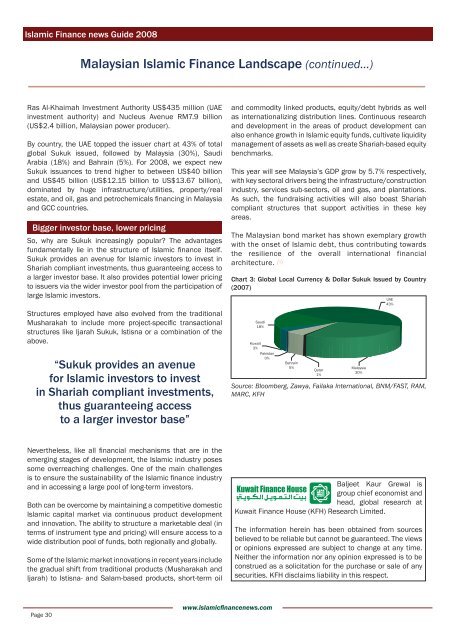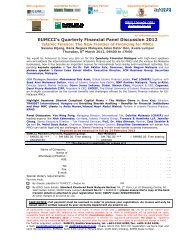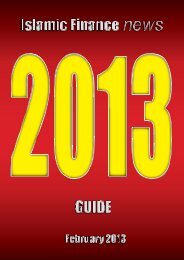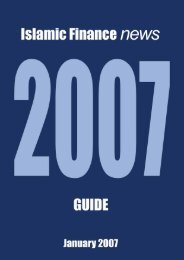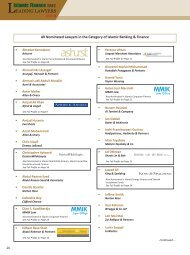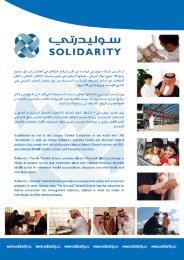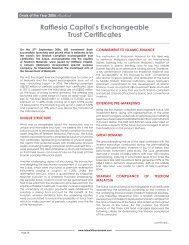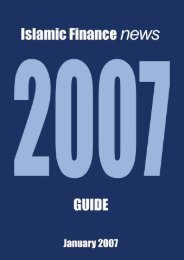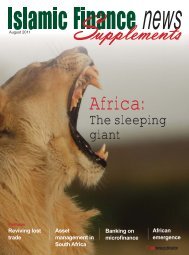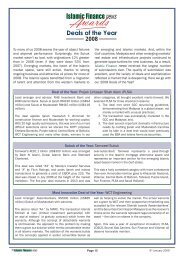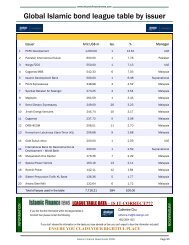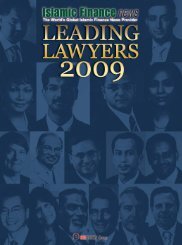You also want an ePaper? Increase the reach of your titles
YUMPU automatically turns print PDFs into web optimized ePapers that Google loves.
<strong>Islamic</strong> <strong>Finance</strong> news Guide 2008<br />
Page 30<br />
Malaysian <strong>Islamic</strong> <strong>Finance</strong> Landscape (<strong>continued</strong>...)<br />
Ras Al-Khaimah Investment Authority US$435 million (UAE<br />
investment authority) and Nucleus Avenue RM7.9 billion<br />
(US$2.4 billion, Malaysian power producer).<br />
By country, the UAE topped the issuer chart at 43% of total<br />
global Sukuk issued, followed by Malaysia (30%), Saudi<br />
Arabia (18%) and Bahrain (5%). For 2008, we expect new<br />
Sukuk issuances to trend higher to between US$40 billion<br />
and US$45 billion (US$12.15 billion to US$13.67 billion),<br />
dominated by huge infrastructure/utilities, property/real<br />
estate, and oil, gas and petrochemicals fi nancing in Malaysia<br />
and GCC countries.<br />
Bigger investor base, lower pricing<br />
So, why are Sukuk increasingly popular? The advantages<br />
fundamentally lie in the structure of <strong>Islamic</strong> fi nance itself.<br />
Sukuk provides an avenue for <strong>Islamic</strong> investors to invest in<br />
Shariah compliant investments, thus guaranteeing access to<br />
a larger investor base. It also provides potential lower pricing<br />
to issuers via the wider investor pool from the participation of<br />
large <strong>Islamic</strong> investors.<br />
Structures employed have also evolved from the traditional<br />
Musharakah to include more project-specifi c transactional<br />
structures like Ijarah Sukuk, Istisna or a combination of the<br />
above.<br />
“Sukuk provides an avenue<br />
for <strong>Islamic</strong> investors to invest<br />
in Shariah compliant investments,<br />
thus guaranteeing access<br />
to a larger investor base”<br />
Nevertheless, like all fi nancial mechanisms that are in the<br />
emerging stages of development, the <strong>Islamic</strong> industry poses<br />
some overreaching challenges. One of the main challenges<br />
is to ensure the sustainability of the <strong>Islamic</strong> fi nance industry<br />
and in accessing a large pool of long-term investors.<br />
Both can be overcome by maintaining a competitive domestic<br />
<strong>Islamic</strong> capital market via continuous product development<br />
and innovation. The ability to structure a marketable deal (in<br />
terms of instrument type and pricing) will ensure access to a<br />
wide distribution pool of funds, both regionally and globally.<br />
Some of the <strong>Islamic</strong> market innovations in recent years include<br />
the gradual shift from traditional products (Musharakah and<br />
Ijarah) to Istisna- and Salam-based products, short-term oil<br />
www.islamicfi nancenews.com<br />
and commodity linked products, equity/debt hybrids as well<br />
as internationalizing distribution lines. Continuous research<br />
and development in the areas of product development can<br />
also enhance growth in <strong>Islamic</strong> equity funds, cultivate liquidity<br />
management of assets as well as create Shariah-based equity<br />
benchmarks.<br />
This year will see Malaysia’s GDP grow by 5.7% respectively,<br />
with key sectoral drivers being the infrastructure/construction<br />
industry, services sub-sectors, oil and gas, and plantations.<br />
As such, the fundraising activities will also boast Shariah<br />
compliant structures that support activities in these key<br />
areas.<br />
The Malaysian bond market has shown exemplary growth<br />
with the onset of <strong>Islamic</strong> debt, thus contributing towards<br />
the resilience of the overall international financial<br />
architecture.<br />
Chart 3: Global Local Currency & Dollar Sukuk Issued by Country<br />
(2007)<br />
Saudi<br />
18%<br />
Kuwait<br />
3%<br />
Pakistan<br />
0%<br />
Bahrain<br />
5%<br />
Qatar<br />
1%<br />
Malaysia<br />
30%<br />
UAE<br />
43%<br />
Source: Bloomberg, Zawya, Failaka International, BNM/FAST, RAM,<br />
MARC, KFH<br />
Baljeet Kaur Grewal is<br />
group chief economist and<br />
head, global research at<br />
Kuwait <strong>Finance</strong> House (KFH) Research Limited.<br />
The information herein has been obtained from sources<br />
believed to be reliable but cannot be guaranteed. The views<br />
or opinions expressed are subject to change at any time.<br />
Neither the information nor any opinion expressed is to be<br />
construed as a solicitation for the purchase or sale of any<br />
securities. KFH disclaims liability in this respect.


